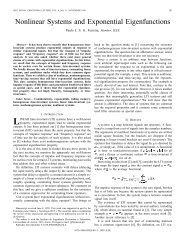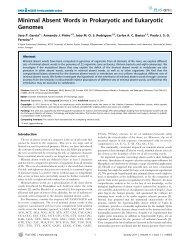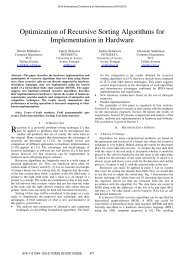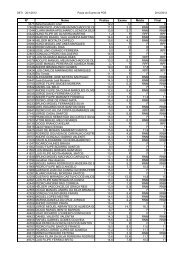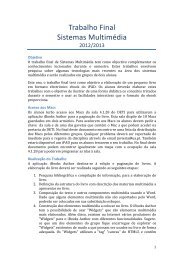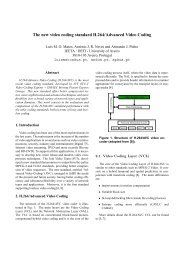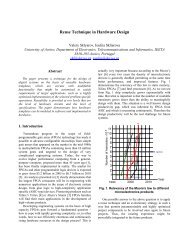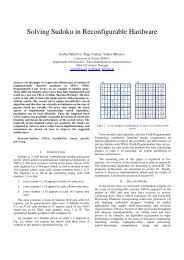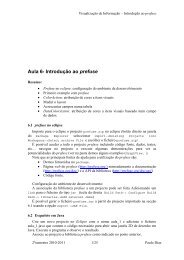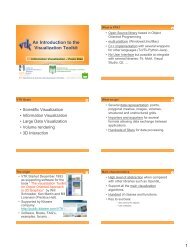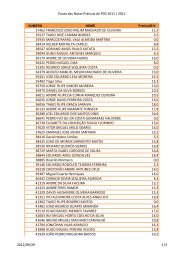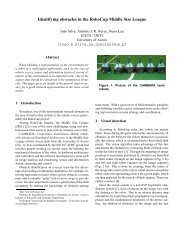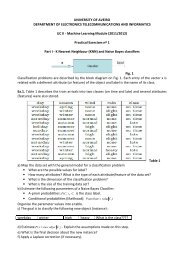DATA SHEET - IEETA
DATA SHEET - IEETA
DATA SHEET - IEETA
You also want an ePaper? Increase the reach of your titles
YUMPU automatically turns print PDFs into web optimized ePapers that Google loves.
Philips Semiconductors Product specification<br />
8-bit microcontroller with on-chip CAN P8xC592<br />
BIT SYMBOL FUNCTION<br />
5 RA Reference Active (notes 2). If the value of RA is:<br />
Notes to the description of the CR bits<br />
1. The test mode is intended for factory testing and not for customer use.<br />
2. A modification of the bits Reference Active and Sync is only possible with Reset Request = HIGH (present). It is<br />
allowed to set these bits while Reset Request is changed from a HIGH level to a LOW level. After an external reset<br />
(pin RST = HIGH) the Reference Active bit is set HIGH (output), the Sync bit is undefined.<br />
3. During an external reset (RST = HIGH) or when the Bus Status bit is set HIGH (Bus-OFF), the IML forces the<br />
Reset Request HIGH (present). After the Reset Request bit is set LOW (absent) the CAN-controller will wait for:<br />
a) One occurrence of the Bus-Free signal (11 recessive bits, see Section 13.6.9.6), if the preceding reset (Reset<br />
Request = HIGH) has been caused by an external reset or a CPU initiated reset.<br />
b) 128 occurrences of Bus-Free, if the preceding reset (Reset Request = HIGH) has been caused by a<br />
CAN-controller initiated Bus-OFF, before re-entering the Bus-On mode, see Section 13.6.9.<br />
c) When Reset Request is set HIGH (present), for whatever reason, the Control, Command, Status and Interrupt<br />
bits are affected, see Table 40. The registers at addresses 4 to 8 are only accessible when the Reset Request is<br />
set HIGH (present).<br />
1996 Jun 27 33<br />
HIGH (output), then the pin REF is an 1 ⁄2AVDD reference output.<br />
4 OIE<br />
LOW (input), then a reference voltage may be input.<br />
Overrun Interrupt Enable. If the value of OIE is:<br />
HIGH (enabled) and the Data Overrun bit is set (see Section 13.5.5) then the CPU<br />
receives an Overrun Interrupt signal.<br />
LOW (disabled), then the CPU receives no Overrun Interrupt signal from the<br />
CAN-controller.<br />
3 EIE Error Interrupt Enable. If the value of EIE is:<br />
HIGH (enabled) and the Error or Bus Status change (see Section 13.5.5) then the CPU<br />
receives an Error Interrupt signal.<br />
LOW (disabled), then the CPU receives no Error Interrupt signal.<br />
2 TIE Transmit Interrupt Enable. If the value of TIE is:<br />
HIGH (enabled) and when a message has been successfully transmitted or the<br />
Transmit Buffer is accessible again, (e.g. after an Abort Transmission command), then<br />
the CAN-controller transmits a Transmit Interrupt signal to the CPU.<br />
LOW (disabled), then there is no transmission of the Transmit Interrupt signal by the<br />
CAN-controller to the CPU.<br />
1 RIE Receive Interrupt Enable. If the value of RIE is:<br />
HIGH (enabled) and when a message has been received without errors, then the<br />
CAN-controller transmits a Receive Interrupt signal to the CPU.<br />
LOW (disabled), then there is no transmission of the Receive Interrupt signal by the<br />
CAN-controller to the CPU.<br />
0 RR Reset Request (note 3). If the value of RR is:<br />
HIGH (present), then detection of a Reset Request results in the CAN-controller<br />
aborting the current transmission/reception of a message entering the reset state<br />
synchronously to the system clock (tSCL, see Section 13.5.9).<br />
LOW (absent), on the HIGH-to-LOW transition of the Reset Request bit, the<br />
CAN-controller returns to its normal operating state.



